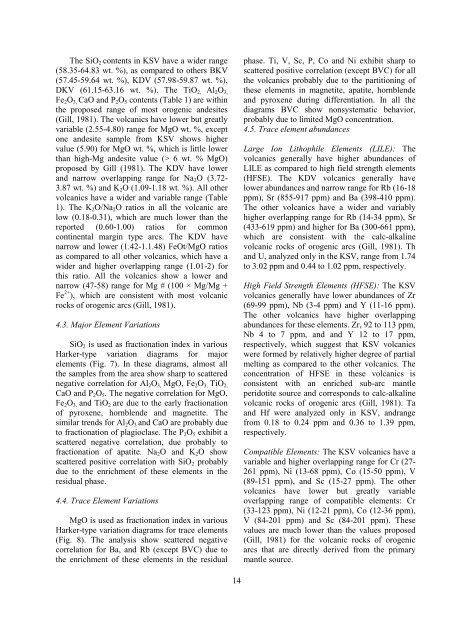Petrogenesis of Plio-Pleistocene volcanic rocks from the chagai arc ...
Petrogenesis of Plio-Pleistocene volcanic rocks from the chagai arc ...
Petrogenesis of Plio-Pleistocene volcanic rocks from the chagai arc ...
Create successful ePaper yourself
Turn your PDF publications into a flip-book with our unique Google optimized e-Paper software.
The SiO 2 contents in KSV have a wider range(58.35-64.83 wt. %), as compared to o<strong>the</strong>rs BKV(57.45-59.64 wt. %), KDV (57.98-59.87 wt. %),DKV (61.15-63.16 wt. %). The TiO 2, Al 2 O 3,Fe 2 O 3, CaO and P 2 O 5 contents (Table 1) are within<strong>the</strong> proposed range <strong>of</strong> most orogenic andesites(Gill, 1981). The <strong>volcanic</strong>s have lower but greatlyvariable (2.55-4.80) range for MgO wt. %, exceptone andesite sample <strong>from</strong> KSV shows highervalue (5.90) for MgO wt. %, which is little lowerthan high-Mg andesite value (> 6 wt. % MgO)proposed by Gill (1981). The KDV have lowerand narrow overlapping range for Na 2 O (3.72-3.87 wt. %) and K 2 O (1.09-1.18 wt. %). All o<strong>the</strong>r<strong>volcanic</strong>s have a wider and variable range (Table1). The K 2 O/Na 2 O ratios in all <strong>the</strong> <strong>volcanic</strong> arelow (0.18-0.31), which are much lower than <strong>the</strong>reported (0.60-1.00) ratios for commoncontinental margin type <strong>arc</strong>s. The KDV havenarrow and lower (1.42-1.1.48) FeOt/MgO ratiosas compared to all o<strong>the</strong>r <strong>volcanic</strong>s, which have awider and higher overlapping range (1.01-2) forthis ratio. All <strong>the</strong> <strong>volcanic</strong>s show a lower andnarrow (47-58) range for Mg # (100 × Mg/Mg +Fe 2+ ), which are consistent with most <strong>volcanic</strong><strong>rocks</strong> <strong>of</strong> orogenic <strong>arc</strong>s (Gill, 1981).4.3. Major Element VariationsSiO 2 is used as fractionation index in variousHarker-type variation diagrams for majorelements (Fig. 7). In <strong>the</strong>se diagrams, almost all<strong>the</strong> samples <strong>from</strong> <strong>the</strong> area show sharp to scatterednegative correlation for Al 2 O 3, MgO, Fe 2 O 3, TiO 2,CaO and P 2 O 5 . The negative correlation for MgO,Fe 2 O 3, and TiO 2 are due to <strong>the</strong> early fractionation<strong>of</strong> pyroxene, hornblende and magnetite. Thesimilar trends for Al 2 O 3 and CaO are probably dueto fractionation <strong>of</strong> plagioclase. The P 2 O 5 exhibit ascattered negative correlation, due probably t<strong>of</strong>ractionation <strong>of</strong> apatite. Na 2 O and K 2 O showscattered positive correlation with SiO 2 probablydue to <strong>the</strong> enrichment <strong>of</strong> <strong>the</strong>se elements in <strong>the</strong>residual phase.4.4. Trace Element VariationsMgO is used as fractionation index in variousHarker-type variation diagrams for trace elements(Fig. 8). The analysis show scattered negativecorrelation for Ba, and Rb (except BVC) due to<strong>the</strong> enrichment <strong>of</strong> <strong>the</strong>se elements in <strong>the</strong> residualphase. Ti, V, Sc, P, Co and Ni exhibit sharp toscattered positive correlation (except BVC) for all<strong>the</strong> <strong>volcanic</strong>s probably due to <strong>the</strong> partitioning <strong>of</strong><strong>the</strong>se elements in magnetite, apatite, hornblendeand pyroxene during differentiation. In all <strong>the</strong>diagrams BVC show nonsystematic behavior,probably due to limited MgO concentration.4.5. Trace element abundancesLarge Ion Lithophile Elements (LILE): The<strong>volcanic</strong>s generally have higher abundances <strong>of</strong>LILE as compared to high field strength elements(HFSE). The KDV <strong>volcanic</strong>s generally havelower abundances and narrow range for Rb (16-18ppm), Sr (855-917 ppm) and Ba (398-410 ppm).The o<strong>the</strong>r <strong>volcanic</strong>s have a wider and variablyhigher overlapping range for Rb (14-34 ppm), Sr(433-619 ppm) and higher for Ba (300-661 ppm),which are consistent with <strong>the</strong> calc-alkaline<strong>volcanic</strong> <strong>rocks</strong> <strong>of</strong> orogenic <strong>arc</strong>s (Gill, 1981). Thand U, analyzed only in <strong>the</strong> KSV, range <strong>from</strong> 1.74to 3.02 ppm and 0.44 to 1.02 ppm, respectively.High Field Strength Elements (HFSE): The KSV<strong>volcanic</strong>s generally have lower abundances <strong>of</strong> Zr(69-99 ppm), Nb (3-4 ppm) and Y (11-16 ppm).The o<strong>the</strong>r <strong>volcanic</strong>s have higher overlappingabundances for <strong>the</strong>se elements. Zr, 92 to 113 ppm,Nb 4 to 7 ppm, and and Y 12 to 17 ppm,respectively, which suggest that KSV <strong>volcanic</strong>swere formed by relatively higher degree <strong>of</strong> partialmelting as compared to <strong>the</strong> o<strong>the</strong>r <strong>volcanic</strong>s. Theconcentration <strong>of</strong> HFSE in <strong>the</strong>se <strong>volcanic</strong>s isconsistent with an enriched sub-<strong>arc</strong> mantleperidotite source and corresponds to calc-alkaline<strong>volcanic</strong> <strong>rocks</strong> <strong>of</strong> orogenic <strong>arc</strong>s (Gill, 1981). Taand Hf were analyzed only in KSV, andrange<strong>from</strong> 0.18 to 0.24 ppm and 0.36 to 1.39 ppm,respectively.Compatible Elements: The KSV <strong>volcanic</strong>s have avariable and higher overlapping range for Cr (27-261 ppm), Ni (13-68 ppm), Co (15-50 ppm), V(89-151 ppm), and Sc (15-27 ppm). The o<strong>the</strong>r<strong>volcanic</strong>s have lower but greatly variableoverlapping range <strong>of</strong> compatible elements: Cr(33-123 ppm), Ni (12-21 ppm), Co (12-36 ppm),V (84-201 ppm) and Sc (84-201 ppm). Thesevalues are much lower than <strong>the</strong> values proposed(Gill, 1981) for <strong>the</strong> <strong>volcanic</strong> <strong>rocks</strong> <strong>of</strong> orogenic<strong>arc</strong>s that are directly derived <strong>from</strong> <strong>the</strong> primarymantle source.14
















